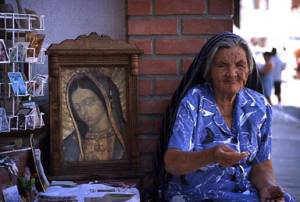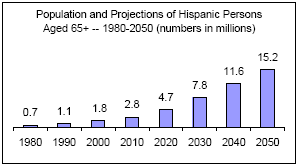|
|
Statistical Profile of Hispanic Senior Citizens Published
Senior Journal
September 22, 2005

Over 36.3 million Americans are aged 65 and over. Three in five people in this age group are women. Over the next forty years, the number of people aged 65 and older is expected to double, while the number of people aged 85 and older is expected to triple.
All Americans are living longer and the same is true for the Hispanic population, according to a new analysis by the U.S. Administration on Aging.

The Older Hispanic Population: Past, Present, and Future
The Hispanic older population was 2.2 million in 2004 and is projected to grow to over 15 million by 2050. In 2004, Hispanic persons made up 6.0 percent of the older population. By 2050, the percentage of the older population that is Hispanic is projected to account for 17.5 percent of the older population. By 2028, the Hispanic population aged 65 and older is projected to be the largest racial/ethnic minority in this age group.
Residence
In 2004, 72% of Hispanic persons aged 65 and over resided in four states: California (27%), Florida (16%), New York (10%), and Texas (19%).
Educational Level
Despite the overall increase in educational attainment among older Americans, there are still substantial educational differences among racial and ethnic groups. In 2004, about 38 percent of the Hispanic population aged 65 and older had finished high school, compared with 73 percent of the total older population. Also in 2004, 8 percent of Hispanic older Americans held a bachelor's degree or higher, compared with 19 percent of all older persons.
Living Arrangements
In 2004, 64 percent of Hispanic older men lived with their spouses, 16 percent lived with other relatives, 4 percent lived with non-relatives, and 16 percent lived alone. For older Hispanic older women, 37 percent lived with their spouses, 36 percent lived with other relatives, 2 percent lived with non-relatives, and 25 percent lived alone. Although older women are more likely to live alone than are older men, the percent of Hispanic elderly men and women living alone is lower than that of the general population. Also, the percent of Hispanic older persons living with other relatives is about twice that of the total older population.
Poverty
The poverty rate in 2004 for Hispanic older persons (65 and older) was 18.7 percent. This was almost twice the percent for the total older population (9.8 percent).
Health
In 2004, only 34 % of Hispanic persons aged 65+ had received pneumococcal vaccination as compared to 69% of non-Hispanic Whites and 39% of non-Hispanic Blacks. (Early Release, 2004 National Health Interview Survey)
In 2004, 11.6% of Hispanic persons aged 65+ needed help from other persons for personal care as compared to 5.6% for non-Hispanic Whites and 8.6% of non-Hispanic Blacks. (Early Release, 2004 National Health Interview Survey)
In 2004, 17.3% of all persons aged 65+ (Hispanic and non-Hispanic) were diagnosed with diabetes. The rate among Hispanic persons is higher since the age-adjusted rate among Hispanic persons is 69% higher than for non-Hispanic Whites. (Early Release, 2004 National Health Interview Survey)
Self -Rated Health Status
During 2000-2002, about 65 percent of Hispanic older men and 61 percent of Hispanic older women reported good or excellent health. Among the total 65+ population, this figure was 73 percent for men and 74 percent for women. Positive health evaluations decline with age. Among Hispanic men ages 65-74, 68 percent reported good or excellent health, compared with 57 percent among those aged 85 or older. Similarly, among Hispanic women this rate declined from 62 percent at age 65-74 to 50 percent at age 85 or older.
Access to Medical Care
In 2000, about 6.7 percent of Hispanic older persons reported that they had no usual source of medical care; 6.5 percent reported delays in obtaining health care due to cost, and , in 2001, 20.7 percent reported that were not satisfied with the quality of the health care which they received.
The comparable figures for the total population aged 65 or older show that 5.1 percent reported that they had no usual source of medical care, 4.8 percent reported delays in obtaining health care due to cost, and, in 2001, 15.6 percent reported that they were not satisfied with the quality of the health care which they received.
Participation in Older Americans Act (OAA) Programs
In 2004, State and Area Agencies on Aging provided services to a total of 8.1 million persons aged 60 and older. Consistent with the targeting requirements of the OAA, the OAA network of state and area agencies on aging placed considerable emphasis on services to persons with the greatest social and economic need, including members of racial and ethnic minority groups, especially those who are poor. Of the older persons who received OAA home and community-based services, 7.0 percent were Hispanic.
About source:
The data for this document are taken from a variety of U.S. Government sources with differing sample sizes and designs. The last section, Participation in Older Americans Act Programs, reports data collected from State Agencies on Aging about persons served with Older Americans Act funds - U.S. Administration on Aging.
|
|



